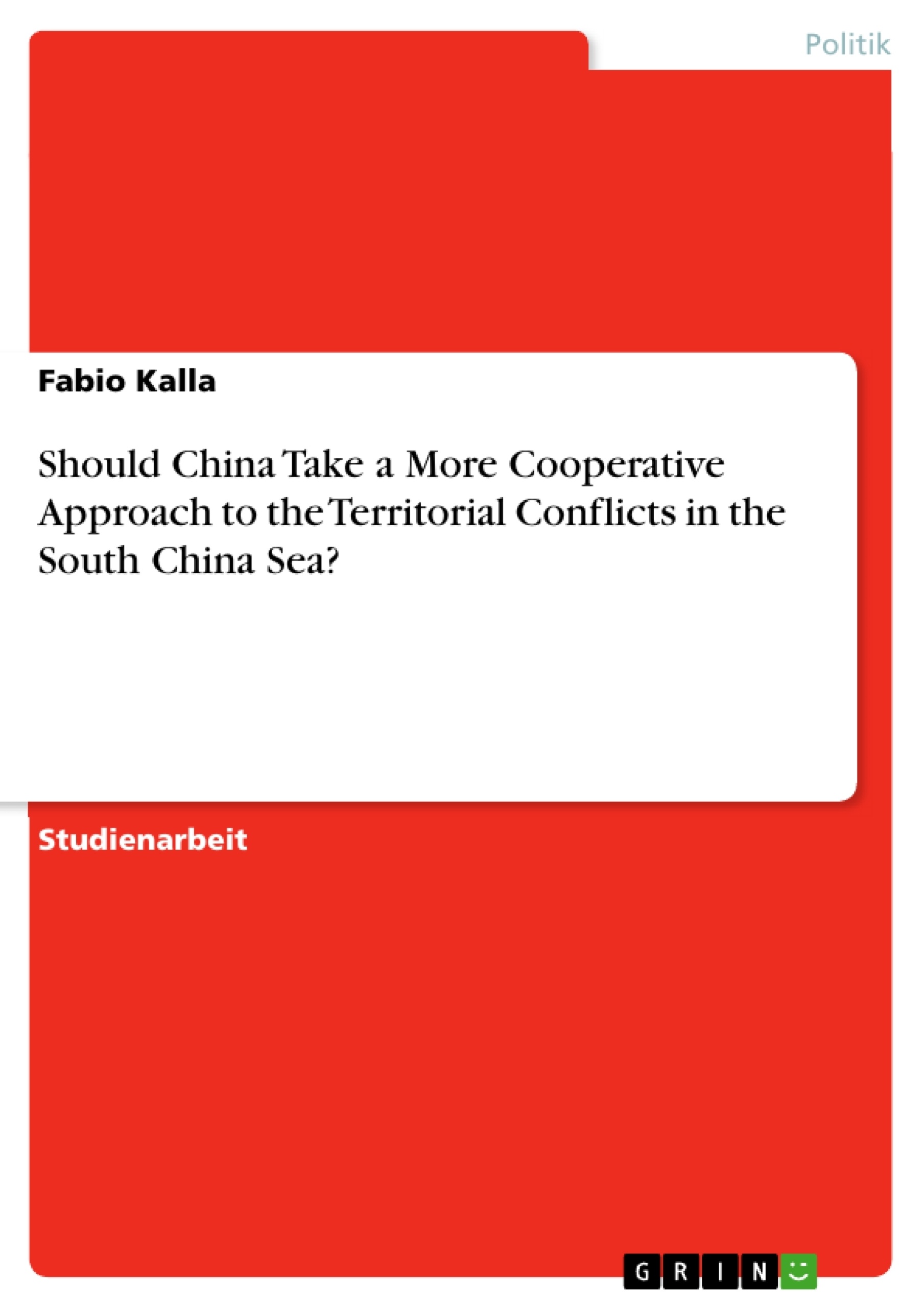In the South China Sea, overlapping territory, maritime and economic claims are the reason for political tension. It is one of the most contested maritime areas in the world. On the seabed, large oil and gas deposits are expected to exist, there are rich fishing grounds and many important trade routes cross the South China Sea. Due to this, also non-claimant nations like the United States want the South China Sea to remain International Waters – to ensure the “Freedom of Navigation”, based in the International Law. The growing Chinese sphere of influence is observed with concern and China as a whole is perceived as a potential threat for the littoral states on the one and the United States on the other hand. Conversely, China accuses these states for claiming an area, which is Chinese territory since ancient times. This thesis examines the existing policy options the Chinese government can apply to reduce the insecurities in the region and to find possible arrangements with the neighboring states. Above all, the question is if China should take a more cooperative approach to the territorial disputes. First, the origins of the conflict will be highlighted, followed by an analysis of the policy options escalation and cooperation. States involved in territorial and maritime conflicts such as the South China Sea dispute have the opportunities to cooperate or to escalate – both options can appear in various forms. At the end of this thesis, there will be one suggested political strategy for the Chinese government to operate in this stretch of water.
Inhaltsverzeichnis
- Introduction
- Origins of the Dispute
- Objects of the Conflict
- Solutions for the South China Sea Conflict
- Chinas Current Strategy
- Policy options
- Escalation
- Cooperation
Zielsetzung und Themenschwerpunkte
Diese Arbeit untersucht die verfügbaren politischen Optionen, die die chinesische Regierung anwenden kann, um die Unsicherheiten in der Region zu reduzieren und mögliche Vereinbarungen mit den Nachbarstaaten zu finden. Im Vordergrund steht die Frage, ob China einen kooperativeren Ansatz bei den Gebietsstreitigkeiten verfolgen sollte.
- Die Entstehung des Konflikts im Südchinesischen Meer
- Die Objekte des Konflikts, wie natürliche Ressourcen und strategische Bedeutung
- Die aktuellen Strategien Chinas im Südchinesischen Meer
- Die Möglichkeiten für Eskalation und Kooperation in dem Konflikt
- Die Möglichkeit eines kooperativeren Ansatzes für China
Zusammenfassung der Kapitel
Introduction
Die Arbeit beleuchtet die Hintergründe des Konflikts im Südchinesischen Meer, der durch sich überschneidende Gebiets-, Meeres- und Wirtschaftsansprüche entsteht. Es werden die wichtigsten Akteure und ihre jeweiligen Ansprüche sowie die Bedeutung der Region für die internationale Schifffahrt, die Fischerei und die Rohstoffgewinnung beschrieben. Die Arbeit fokussiert sich auf die Frage, ob China einen kooperativeren Ansatz bei der Lösung des Konflikts verfolgen sollte.
Origins of the Dispute
Dieses Kapitel untersucht die historischen Wurzeln des Konflikts im Südchinesischen Meer. Es werden die historischen Ansprüche der beteiligten Staaten, insbesondere Chinas und Vietnams, anhand von Karten und Dokumenten beleuchtet. Die Rolle internationaler Abkommen wie der UNCLOS und die damit verbundenen territorialen Ansprüche werden erläutert.
Objects of the Conflict
Dieses Kapitel beleuchtet die verschiedenen Konfliktgegenstände im Südchinesischen Meer. Neben den territorialen Ansprüchen werden die Bedeutung der Region für die Fischerei, die Rohstoffgewinnung und die internationale Schifffahrt hervorgehoben. Es wird die Bedeutung der "Freedom of Navigation" für die USA und die strategische Bedeutung des Meeres für China diskutiert.
Schlüsselwörter
Südchinesisches Meer, Gebietsstreit, Territorialansprüche, Meeresrecht, UNCLOS, China, Vietnam, Philippinen, Malaysia, USA, Freedom of Navigation, Ressourcen, Fischerei, Rohstoffe, strategische Bedeutung, Eskalation, Kooperation.
- Citation du texte
- Fabio Kalla (Auteur), 2017, Should China Take a More Cooperative Approach to the Territorial Conflicts in the South China Sea?, Munich, GRIN Verlag, https://www.grin.com/document/424907



